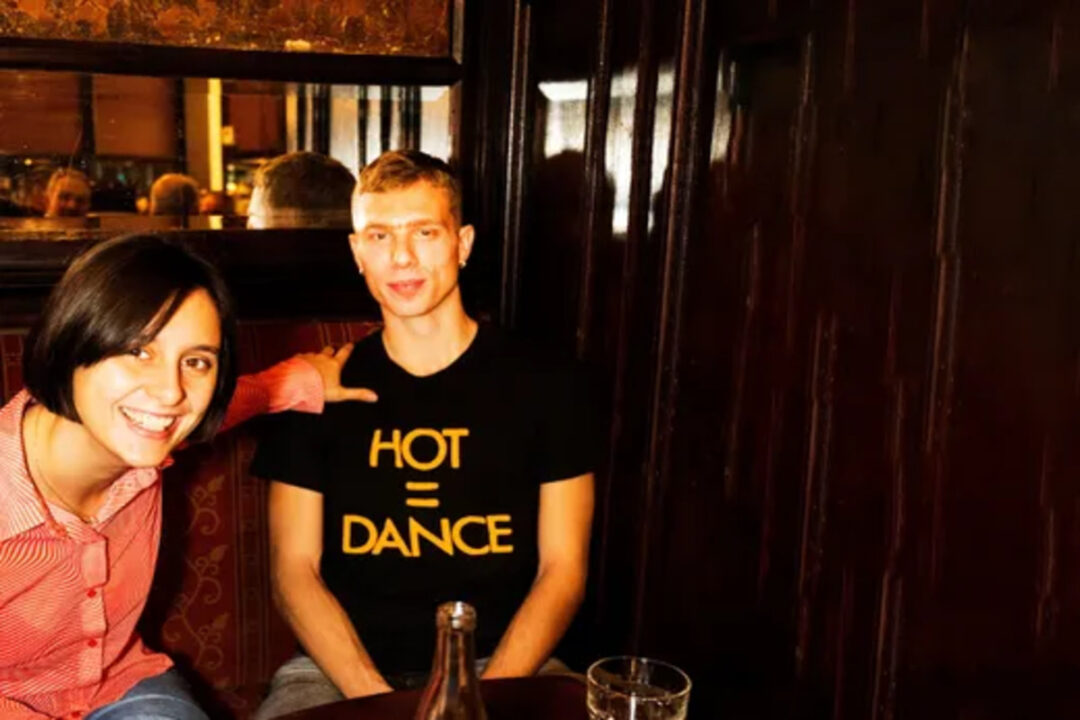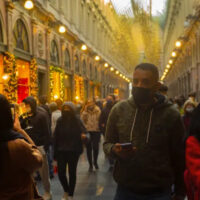Belgium, (Brussels Morning Newspaper) You can already read the small talk with the Brussels theater makers Anna Franziska Jäger and Nathan Ooms in magazine. Now in corner of café Le Cirio, there was a talk about their profession, their way of working (together) and their most recent performance Ambient Theater Fury , which is bathed in an ambiguous ambient atmosphere.
Having episode 4 of series 3 on Netflix, while you’re actually already half asleep. Keep scrolling on the smartphone while registering only half of what you see. Or vice versa: sitting at the table with friends while you are actually more busy with that smartphone. If this split ambient lifestyle sounds familiar to you, try to catch up with it now.
Since Nathan Ooms and Anna Franziska Jäger, two theater makers born in 1996, met as Master’s students in Drama at KASK in Ghent, their creative collaborative relationship has already resulted in at least five captivating productions, including recently Bartlebabe, The Honey House, and now Ambient Theater Fury . At the moment, Ooms and Jäger are in the busy meantime after the premiere of that last piece and the making of another one. Yet, in addition to writing the dossier and pitching and developing ideas for that next play, they also make time to thoroughly evaluate Ambient Theater Fury .
Ooms: “Reflecting on the previous performance and examining how we will relate to it in the next piece is often the first phase of any new project. We try to expose what problems we still struggled with. There are always something like that.”
Jäger: “It’s a bit dialectical: you make something and that provokes a countermovement, after each performance you ask yourself what you want from theater and art. Each new performance confronts you with the question of what your view of humanity and the world is.”
Perhaps our work is perceived more cynically than we ourselves estimate
NATHAN OOMS
Ambient Theater Fury
One of the questions they ask themselves, also because it was touched on in the first reviews, is how cynical the world view that Ambient Theater Fury is. In the nineties ‘ambient’ was a genre designation for a spherical variant of electronic music.
Ooms: “But more broadly it is about an activity, a state or an experience that consumes your brain activity and attention, but still allows you to be busy with something else.”
Jäger: “The characters seek contact with each other, but are also absent at the same time. Their way of speaking and communicating gives the impression that they may be busy with something completely different in the meantime. This leads to a strange dialogue.”
In their previous piece Bartlebae , Jäger gave a solo performance to a person exhausted by marketing talk, online temptation and efficiency thinking. Ambient Theater Fury also evokes such a human condition (albeit in an intensified form): the half-attentive, binge-watching, dozing human routinely divides his attention and brain activity between the analog and the digital reality, the hyper-individual bubble and the hyper-connected network, about one’s own heart and the all-knowing algorithm. This human being wavers between self-expression and quote, ego and image, dream and deed. Indeed, that does not all look very optimistic.
“Perhaps our work is perceived as more cynical than we think it is,” says Ooms.
Jäger: “We have immersed ourselves in a certain darkness and emptiness. It’s not surprising that people get that out of it too. We also made that performance because we struggled with the subject ourselves and want to get past that cynicism. When you get a little older, you may not be so quick to conclude that everything is screwed up. That light and darkness relate to each other in a more complex way.”
Ooms: “Such an ambient experience naturally has a negative connotation. It is about disconnection, isolation and inaccessibility. For example, one of the conditions in which you find the ‘numbness’ of ambient is the constant idea of crisis that has accompanied us in recent years. As we move from crisis to crisis, the word ‘crisis’ becomes elusive in a sense. Another tendency is that people turn inward, seek the truth within themselves. Because even though we all look at the same thing, we all look alone, and everyone can enter individually at any time shutdown individually at any time . On the other hand, it is questionable why we are attracted to cultural production that is characterized by such an ambient atmosphere. What’s the anesthesia for?”
Jäger: “Cause and effect are not so easy to identify. Take social media: it did not arise in a vacuum. There was already talk of individualization before social media came into being. So they did not create it, but they may have strengthened it. Or relationships: were they pure and unmediated before the dating apps? It’s hard to moralize. So we don’t just see those ambient phenomena as ‘destruction’ for spirit or culture, it’s something we try to understand.”
Ooms: “That’s why our piece also has that thin line between the cliché and emptiness of our characters and the bigger story behind it. Hopefully that will be visible through the cracks we use in the theatrical form.”
It is by questioning and challenging each other that we get further in our research
ANNA FRANZISKA JAEGER
Death of dialogue
In addition, Ambient Theater Fury (subtitle : The death of dialogue – and how to avoid it ) gives us much more to think about. In Bartlebabe there was a lot of references, fragmentation and transformation; the audience was constantly chasing that one inimitable character. Ambient Theater Fury focuses on continuity, repetition and emotionality and the characters have incorporated a certain psychology. Where Bartlebabe recalled themes by Kafka and Herman Melville, Ambient Theater Fury adds material from A Man Who Sleepsby Georges Perec adds another layer on the relationship and dialogue between the ‘me’ and ‘the other’, and the ‘inner eye’ through which we look at ourselves through another.
Is it easy to trust that the material you put into a creation during a whole year’s making process will also be tangible and visible to the public once the piece is finished? After all, Uncles and Jäger don’t make pieces with a lot of scenery or a lot of words, but try to say a lot with just their two bodies and some props.
Ooms: “The way we work is always different. We look for what we need to express what we want to express. Often that is not so much because more and more things fall away along the way. In this case, it sure was exciting. As a maker you spend so long in that process of adding and removing layers and then you are on stage with that whole history, but for the spectator it is of course a first meeting. Still, I believe that a creative practice can be felt on stage. It influences the way you bring something.”
In the meantime, there are already plans for a group performance in 2024. Ooms and Jäger are clearly not finished talking or looking forward to each other. During our conversation it becomes clear that they regularly supplement or nuance each other’s sentences. Are we dealing here with one theater brain? Or does it sometimes clash when they forge theater plans together? “A combination of the two,” says Ooms. “Due to the intensity of our collaboration, it is also welcome to have someone else in the studio to crack it open every now and then, such as designer Carly Ray Heathcote or dramaturge Bojana Cvejić.” “We are very complementary,” adds Jäger, “but of course we also have discussions and different ideas. It is by questioning and challenging each other that we get further in our research.”



